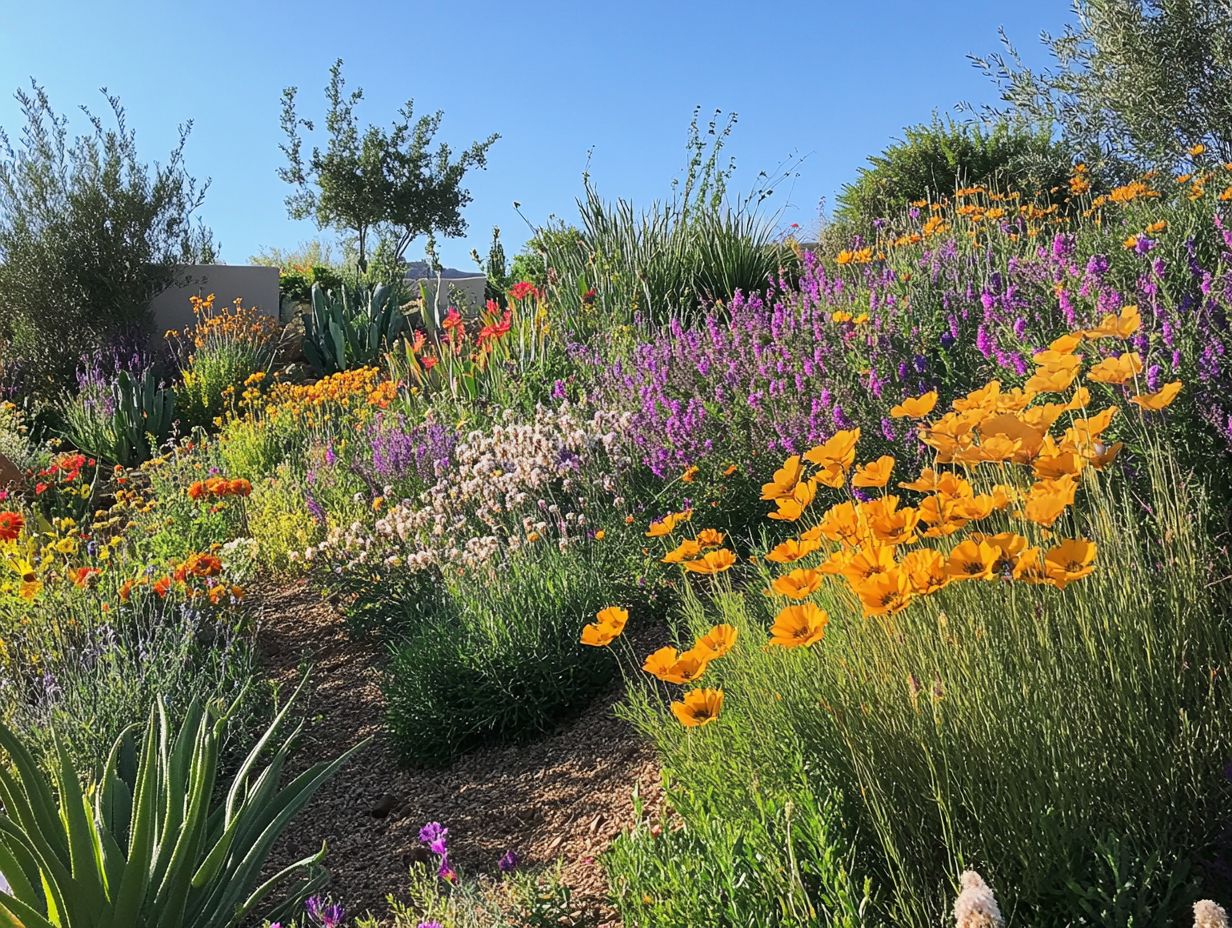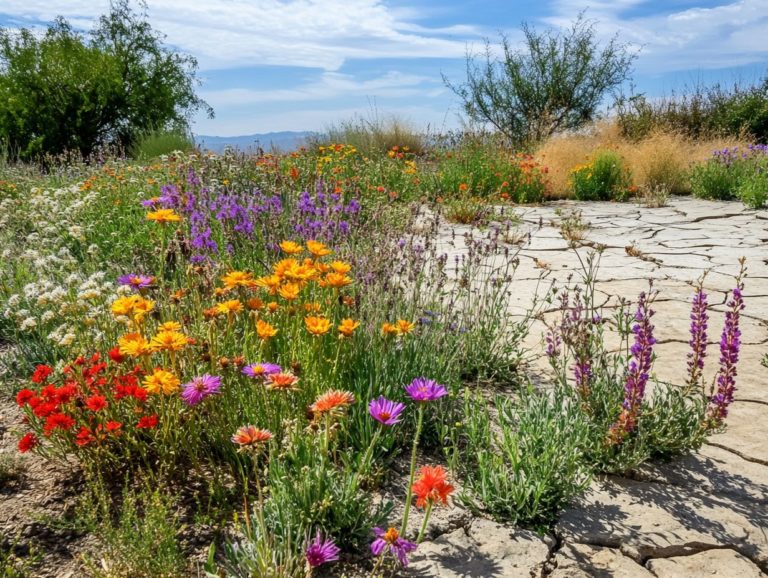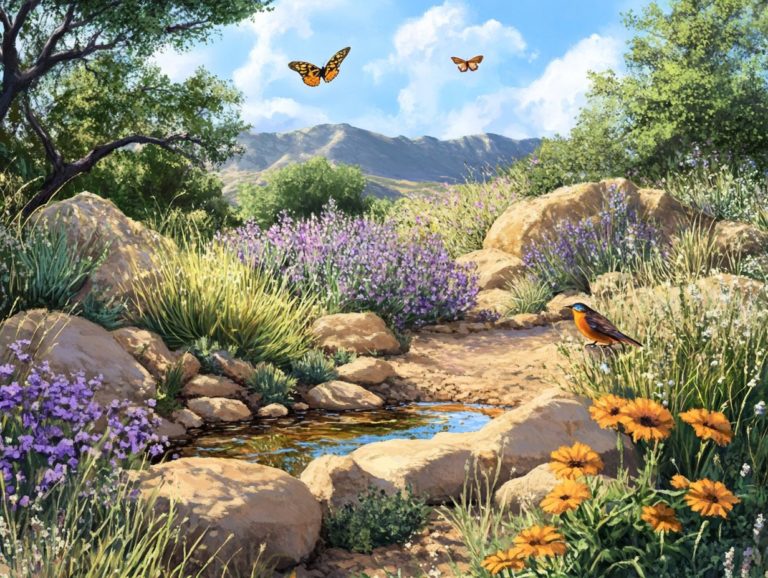Can I Use Native Plants for Drought Resistance?
Drought resistance is gaining prominence as climate patterns shift and water resources become scarce.
A highly effective strategy to address these challenges is to incorporate native plants into your landscape. These resilient species are perfectly adapted to local conditions, providing significant environmental benefits and cost savings.
This article delves into what drought resistance entails, the many benefits of utilizing native plants, and practical guidance on selecting, incorporating, and maintaining them in your garden design.
Explore how these strategies can elevate your outdoor space while championing sustainability.
Contents
- Key Takeaways:
- Understanding Drought Resistance
- Benefits of Using Native Plants for Drought Resistance
- Choosing Native Plants for Drought Resistance
- How to Incorporate Native Plants into Your Landscape
- Maintaining Native Plants for Drought Resistance
- Frequently Asked Questions
- Ready to discover how native plants can boost drought resistance?
- Why are native plants better for drought resistance?
- What are some examples of native plants that are drought resistant?
- Do native plants require less water than non-native plants?
- How do native plants help conserve water during a drought?
- Can I use native plants for drought resistance in any climate?
Key Takeaways:

- Using native plants for drought resistance has numerous environmental benefits, such as promoting biodiversity and conserving water resources.
- Incorporating native plants into your landscape design can also result in cost savings, as they are adapted to the local climate and require less plant maintenance and resources.
- When choosing native plants for drought resistance, consider factors such as soil health, sun exposure, and water availability to ensure they thrive in your specific environment.
Understanding Drought Resistance
Understanding drought resistance is crucial in today s shifting climate. Extreme weather patterns test traditional landscaping methods.
Drought resistance refers to a plant’s unique ability to endure periods of water scarcity. These adaptations enhance their survival and growth.
This becomes significant when you consider integrating drought-tolerant species that flourish in local conditions, thereby enhancing soil health and fostering garden design.
As climate change continues to unfold, incorporating these resilient plants into your landscapes not only champions water conservation but also supports native ecosystems while elevating the visual interest of your gardens.
What is Drought Resistance?
Drought resistance embodies the remarkable ability of plants to survive and flourish even when water is scarce. These traits are extraordinary, such as drought-tolerant adaptations and impressive plant hardiness.
These resilient species deploy various mechanisms to conserve water and sustain their physiological functions. For instance, they develop deep root systems that reach for underground moisture or feature specialized leaf structures designed to minimize evaporation.
Some plants take it a step further, altering their growth patterns to enter a dormant state during extended dry spells, only to spring back to life when conditions improve. Others boast incredible adaptations, such as waxy cuticles and smaller leaf surfaces, which significantly reduce water loss while allowing them to withstand harsh environments.
Together, these adaptations enhance survival and illuminate the remarkable resilience of nature in the face of climate challenges.
Benefits of Using Native Plants for Drought Resistance
Utilizing native plants for drought resistance provides you with a wealth of advantages. Not only do they enhance environmental benefits that support local biodiversity, but you can also learn more about the importance of native plants in drought areas, which offer significant cost savings by reducing maintenance needs.
You will see better water conservation in your home gardens and landscapes. This choice is practical and has a lasting impact.
Environmental Benefits
The environmental benefits of using native plants in drought-resistant landscaping are nothing short of remarkable. By fostering native ecosystems, you provide crucial support for local wildlife.
Using plants that thrive in your local climate boosts your landscape’s beauty. It also helps the environment stay healthy. Native species, equipped with deep root systems and resilience to local weather patterns, play a pivotal role in conserving water and minimizing reliance on chemical fertilizers and pesticides.
These plants often serve as essential food and habitat sources for a variety of wildlife, including vital pollinators like bees and butterflies. As biodiversity flourishes, the robustness of local ecosystems strengthens, ultimately promoting sustainability and restoring balance in the natural world.
Cost Savings

Choosing drought-resistant native plants offers you a compelling opportunity for big savings, especially when you learn how to design a drought-resistant landscape, thanks to reduced maintenance and lower water requirements.
By incorporating these hardy plants into your garden design, you can ease the burden of constant watering. This allows you to trim down landscaping expenses.
Over time, adopting low-maintenance gardening practices will lead to a noticeable decrease in your utility bills, fostering a more sustainable outdoor environment. This strategic approach allows you to allocate resources more wisely, freeing up funds to invest in other aspects of your landscape.
Spending less on fertilizers and pest management not only benefits your budget but also promotes lasting ecological advantages. Drought-resistant plants are a smart financial choice for any garden enthusiast interested in low-maintenance practices.
Choosing Native Plants for Drought Resistance
Choosing the right native plants for drought resistance requires a thoughtful approach. You’ll want to consider key factors, such as local conditions, plant hardiness, and the unique requirements of your garden design. For more insights, explore using native plants in drought landscapes.
By doing so, you can create a flourishing landscape that thrives even in dry spells.
Factors to Consider
When selecting native plants for drought resistance, keep several key factors in mind: understanding your local conditions, assessing the hardiness of potential plants, and evaluating the specific needs of your landscape.
Local climate patterns, soil type, and water availability are essential in determining which plants will thrive in your area. For example, knowing whether your soil drains well or retains moisture can help you choose species that perform best in those conditions.
Plant hardiness refers to a plant’s ability to survive in specific temperature ranges. Native plants often come with natural adaptations that enable them to withstand extended dry spells, making them a far better choice than non-natives.
Considering the ecological balance of your landscape, as well as the presence of pollinators and wildlife support, will enhance the effectiveness of your plant selections. This ensures a resilient and vibrant ecosystem.
How to Incorporate Native Plants into Your Landscape
These plants can transform your garden! Incorporating native plants into your landscape provides sustainable water-saving solutions and infuses your outdoor spaces with vibrant visual interest.
Design Tips and Techniques
Utilizing effective design tips and techniques when incorporating native plants will elevate your landscape. It ensures it is not only visually captivating but also fosters biodiversity and resilience against drought.
Strategically arranging these plants enhances their natural beauty while supporting local ecosystems. Consider mixing plant heights and textures to create dynamic layers, and choose a cohesive color palette that harmonizes with the surrounding environment.
To maintain year-round vibrancy, select a variety of species that bloom at different times, offering seasonal interest and beauty.
By employing native plants, you also reduce the need for chemical fertilizers and extensive irrigation. This makes your landscape more sustainable and easier to maintain.
Maintaining Native Plants for Drought Resistance

Proper care and maintenance of native plants are essential for ensuring their longevity and effectiveness as drought-resistant features in your garden design.
By adopting low-maintenance approaches, you can create a resilient landscape that thrives with minimal effort.
Proper Care and Maintenance
Ensuring proper care and maintenance of native plants can significantly enhance their ability to resist drought. For tips on selecting the best options, check out this guide on how to choose drought-resistant plants. This focus also minimizes your overall garden upkeep.
By following a few best practices, you can create a thriving environment that showcases the beauty and resilience of local flora.
For instance, when it comes to watering, adopt a schedule that mirrors the natural rainfall patterns of your area. This approach promotes deep root growth and improves soil health.
When it s time to fertilize, do so with care. Using organic, slow-release options will nourish your plants without overwhelming them.
Strategic pruning encourages healthy growth and rejuvenates older plants, boosting their aesthetic appeal.
By embracing these techniques, you can cultivate a garden that demands less of your attention while providing an eco-friendly habitat that attracts beneficial wildlife.
Final Thoughts and Recommendations
Embracing native plants in drought gardening is a savvy choice for sustainable gardening. It offers a wealth of benefits that range from water conservation to increased resilience against climate change.
By selecting plants that naturally flourish in your local climate, you can significantly reduce your water usage while promoting biodiversity in your landscape.
Native plants not only endure periods of limited rainfall, they also demand far less maintenance than their non-native counterparts.
If you re considering this transition, start small with a few carefully chosen native perennials, grasses, and shrubs. You ll be amazed at the remarkable difference this can make!
Creating a well-defined planting area with mulch, which is a covering for the soil, can further boost water retention and improve soil health.
Engaging with local gardening clubs or extension services can also provide invaluable resources and insights into the best native varieties suited to your specific region.
Frequently Asked Questions
Ready to discover how native plants can boost drought resistance?
Yes, using native plants is a great way to improve drought resistance in your landscape.
Why are native plants better for drought resistance?

Native plants are adapted to the local climate and soil conditions, making them more resilient to drought conditions and ideal for those seeking the best drought-resistant plants.
What are some examples of native plants that are drought resistant?
Examples include cacti, succulents, yuccas, and wildflowers such as black-eyed Susans and coneflowers.
Do native plants require less water than non-native plants?
Yes, native plants have evolved to thrive in their natural environment, so they typically require less water than non-native plants.
How do native plants help conserve water during a drought?
Native plants have deep root systems that can access water deep in the soil, reducing the need for frequent watering. They also help to prevent erosion and retain moisture in the soil.
Can I use native plants for drought resistance in any climate?
While native plants are best suited for their specific region, the benefits of native drought-resistant plants are available for most climates. It’s important to research and consult with local experts to determine the best options for your specific location.






